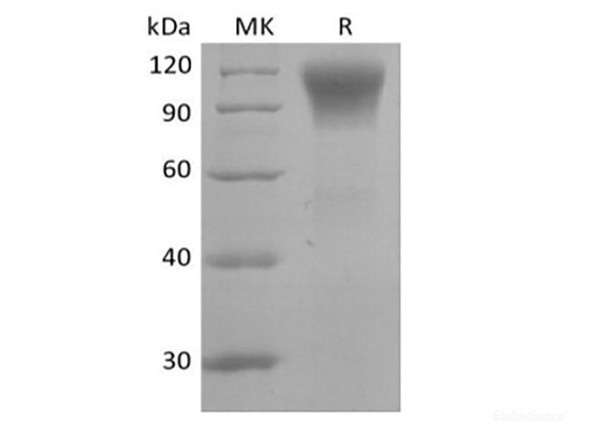Description
| Product Name: | Recombinant Human IGF-I R/IGF1R (C-6His) |
| Product Code: | RPES6362 |
| Size: | 10µg |
| Species: | Human |
| Expression Host: | HEK293 Cells |
| Synonyms: | CD221 antigen, CD221, IGF1R, IGF-1R, IGF-I R, IGF-I receptor, IGFIR, IGF-IR, IGFR, insulin-like growth factor 1 receptor, JTK13 |
| Mol Mass: | 103.7&81&22.7 kDa |
| AP Mol Mass: | 100-130&54 kDa |
| Tag: | C-6His |
| Purity: | > 95 % as determined by reducing SDS-PAGE. |
| Endotoxin Level: | < 1.0 EU per μg of the protein as determined by the LAL method. |
| Bio Activity: | Testing in progress |
| Sequence: | Glu31Asn932 |
| Accession: | P08069 |
| Storage: | Generally, lyophilized proteins are stable for up to 12 months when stored at -20 to -80°C. Reconstituted protein solution can be stored at 4-8°C for 2-7 days. Aliquots of reconstituted samples are stable at < -20°C for 3 months. |
| Shipping: | This product is provided as lyophilized powder which is shipped with ice packs. |
| Formulation: | Lyophilized from a 0.2 μm filtered solution of PBS, 1mM EDTA , 0.5% Tween-20, 5% Trehalose, pH 7.4. Normally 5 % - 8 % trehalose, mannitol and 0.01% Tween80 are added as protectants before lyophilization. Please refer to the specific buffer inform |
| Reconstitution: | Please refer to the printed manual for detailed information. |
| Background: | The insulin-like growth factor-1 receptor (IGF1R) is a transmembrane tyrosine kinase involved in several biological processes including cell proliferation, differentiation, DNA repair, and cell survival. This a disulfide-linked heterotetrameric transmembrane protein consisting of two α and two β subunits, and among which, the α subunit is extracellular while the β subunit has an extracellular domain, a transmembrane domain and a cytoplasmic tyrosine kinase domain. The IGF-I receptor is highly expressed in all cell types and tissues. Essentially all of the biological activities of IGF-I and II have been shown to be mediated via IGF-I R. IGF1R is an important signaling molecule in cancer cells and plays an essential role in the establishment and maintenance of the transformed phenotype. Inhibition of IGF1R signaling thus appears to be a promising strategy to interfere with the growth and survival of cancer cells, is now an attractive anti-cancer treatment target. |






